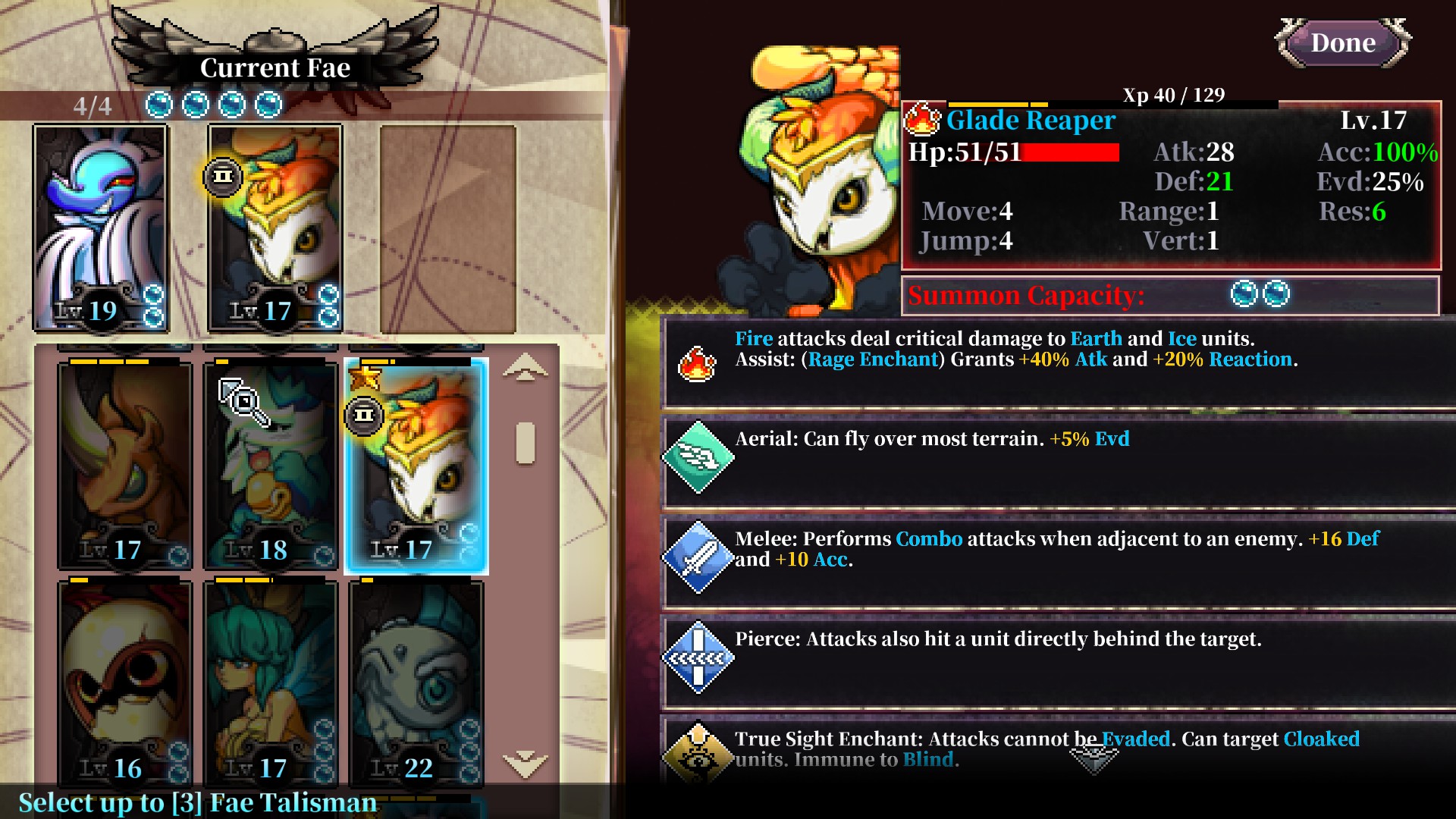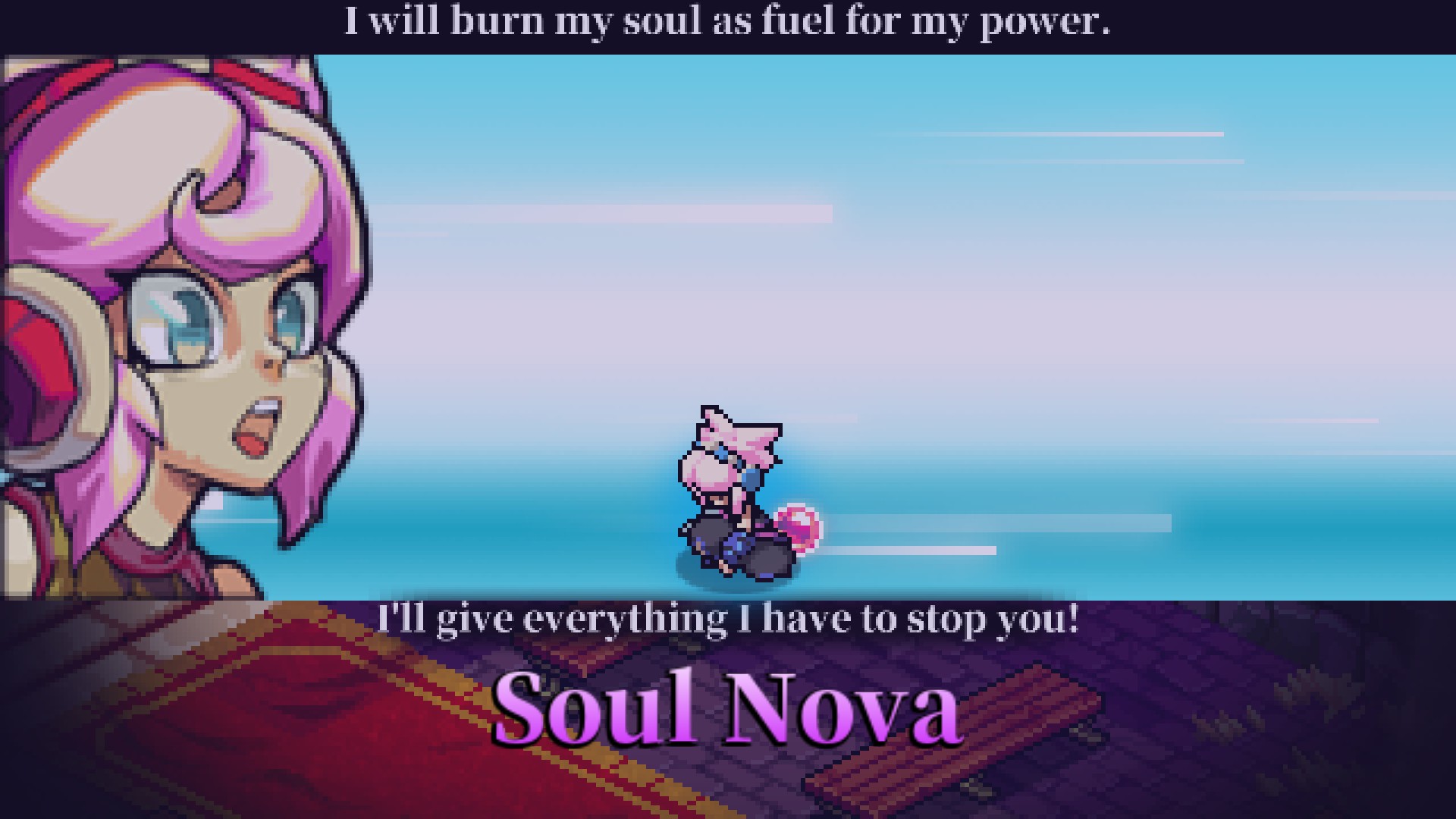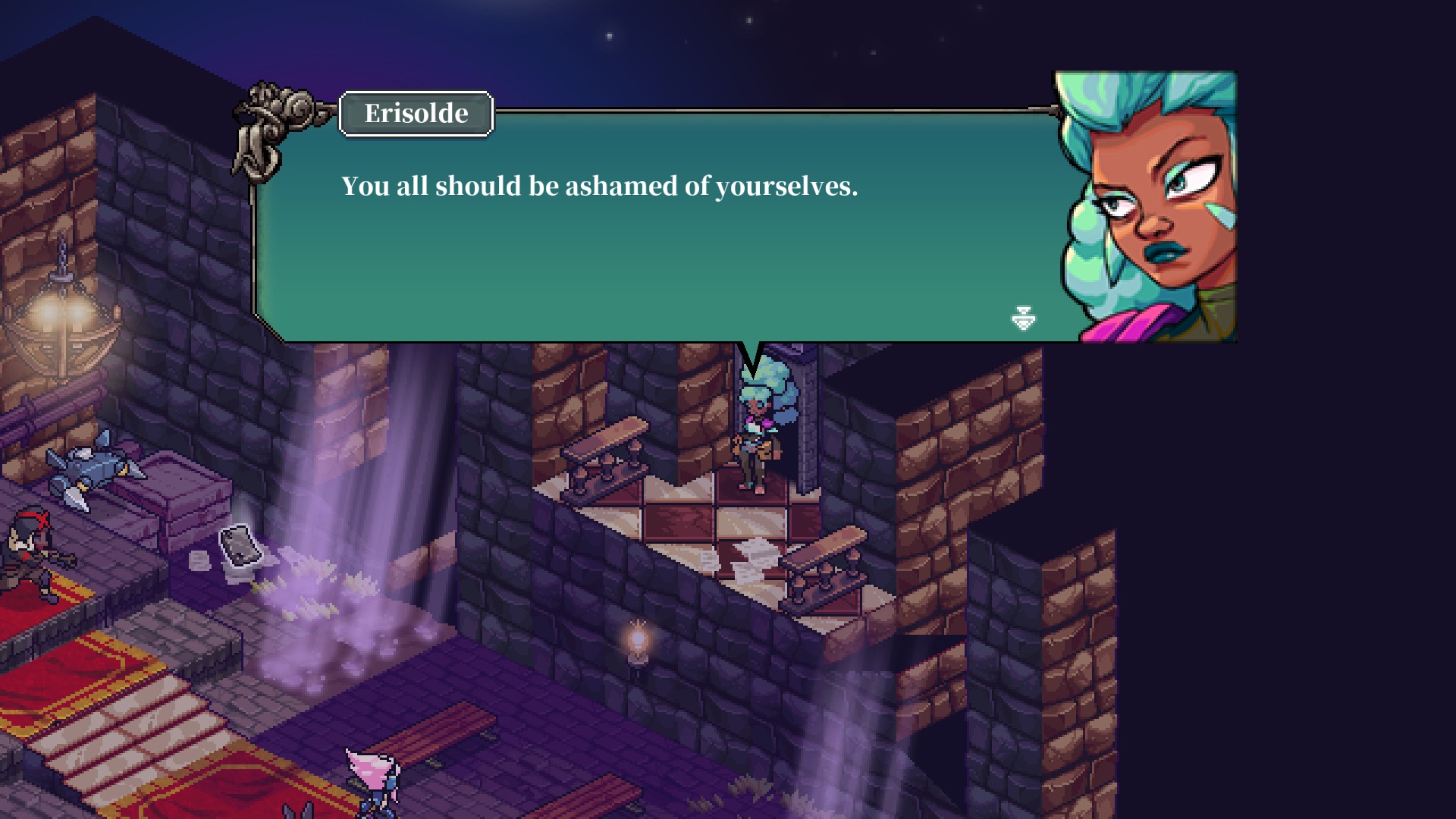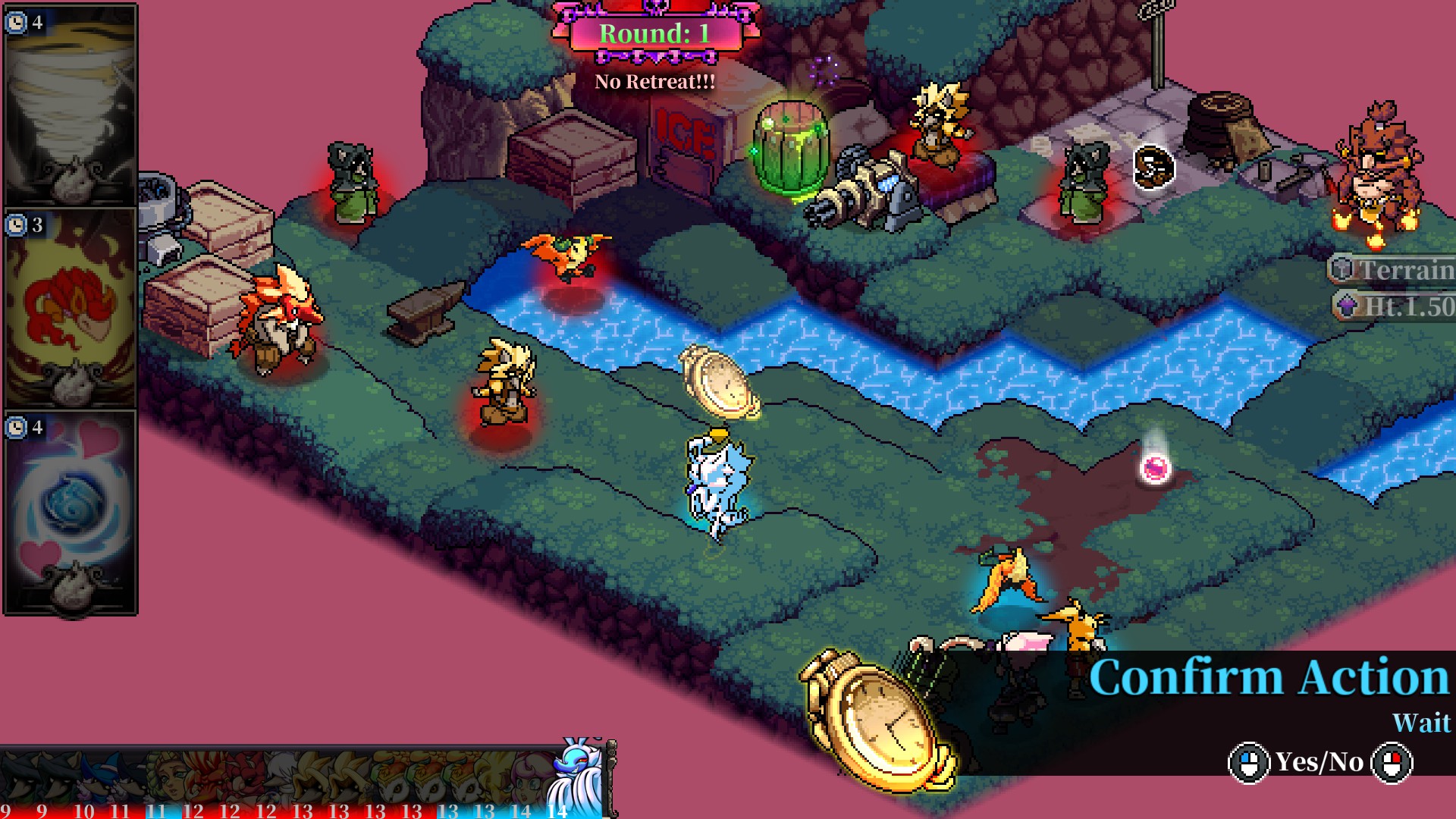Some games are a brutal combination of both frustration and exhilaration. I found Fae Tactics: The Girl Who Destroyed the World to be such a game, and I’m keeping this strange combination in mind as I write this review. In all honesty, there were times during my playthrough when I genuinely wanted nothing more than to throw my controller to the ground and scream, and then there were other times when the stars seemed to align perfectly and I’d jump up for joy over a hard-won victory that had me feeling giddy.
The plot of Fae Tactics is set in the aftermath of an event that forced the human and fae worlds to come together. Players take on the role of Peony, a girl traversing with her loyal companions Payachin and Chico while on a mission to find her missing mother. Peony is one of the few humans who can use magic, and is often viewed with distrust and suspicion by other characters. However, her usage of magic in the plot impacts actual gameplay, as it grants the “little witch” the ability to summon fae creatures to her side to help in combat once she acquires their respective talisman out on the battlefield. These summons significantly help pad out fights, as your battle party in Fae Tactics consists of only Peony, two party member leaders, and however many summons you can have on the field at a given time, as higher ranked summons generally take up more party space.

Battles are generally straightforward albeit challenging affairs, where the enemy levels are wholly dependent on Peony’s own. As such, this is not a game where one can level grind and expect to be at a clear statistical advantage over their foes. Anyone with an inkling of familiarity with grid-based SRPGs will find themselves at home with the setup, though there are some nuances and differences that require more of a learning curve for gamers. For starters, Fae Tactics totes a “menuless” system to keep players from being overwhelmed by the usual amount of menu traversing one often associates with SRPGs. Characters can move when it is their turn and, depending on who they are in range of, be it ally or adversary, can either opt to attack or assist right off the bat. There is even a “wait” option that will boost skills or stats for when you aren’t in range of another character.
Depending on what weapons are equipped or skills a character has, they might be able to chain attacks together to assault multiple enemies at once, or a group of characters might be able to gang up on a surrounded target using a string of highly effective combo moves. Every successful ability used gains party leaders, the characters who aren’t summons, at least one point towards their Ultra meter. When the Ultra meter is full, it can be used to inflict a devastating blow or a powerful assist in the next round of fighting or counter-action. However, a weak point of the title is that there is no way to hold off on using an Ultra when it is ready, and you’re not always going to be able to time them for the most ideal strategic use.

Certain character units in Fae Tactics also have something called a Mana Barrier that has to be “broken down” before damage can be done to their hit points. Mana Barriers can provide a lot of cushion from attacks, so careful strategy is required to effectively deal with them. Party members all have respective weapons they gain over the course of the game that provide special stat or attack boosts, often along with elemental affinity. Keeping in mind the elemental affinities of enemies as well as the weather conditions of the battlefields themselves when selecting characters for battle is a key strategic component in the game.
Party members can also boost certain stats and abilities by equipping Traits to themselves; traits are essentially skill points given to a character upon their leveling up. Scrolls, along with their respective weapons, can also be equipped as accessories to a character and offer either a status boost or skill, such as increasing initial defense, lowering defense upon attacking, or a helpful ability such as draining a Mana Barrier with every successful hit. Height differences during fights allows for an increased damage output the higher up you are from an opponent. Peony also has access to one spell per round once the cooldown period for that particular magic has been reached. Spell talismans picked up on fields range from healing and outright offensive to status boosting and draining. She can only equip three spell talismans per fight though, so players must really think about which ones might make a difference in a fight.
Fights occur on a world map that players can traverse at their leisure. The game boasts an element of choice in how players can approach fights and seeing story scenes play out, and in theory it is a neat approach to ensuring no playthrough is exactly alike. Unfortunately, this approach is not without its flaws, as there can be a bit of a disconnect to the narrative flow given the different destinations and story battles one can take part in. In my playthrough, I also ran into a glitch that occurred because I had done the Erisolde recruitment storyline much earlier than a certain event involving the centaur Orowantus. Once this event opened up later on in the game and I played through it, the Erisolde storyline reset itself and I had to fight through several fierce battles again in order to get her to join my party once more and progress the game’s story. This seemed to occur largely because of the “freedom” granted by the choice mechanic for picking story fights, though how often it occurs I can’t say exactly. I just didn’t care for repeating roughly ten hours worth of fights and stories.

These battles take a day of game time to complete. Progressing through fights, (including Free Battles, which can be used to gather materials for crafting or to collect more summons and gain more spells) opens up further plot points and battles. Some battles are staggered with the expectation of fighting two to three fights in a row. This is perhaps the game’s largest frustration point, as there is no way to return to the world map should you need to do so without losing all of your progress in the fights you’ve already won — worse still if you find that you need to Free Battle more to help overcome that pesky boss fight or tough challenge at the end. And there is no avoiding this at certain points in the game; I found myself spending hours on those “final tier” fights without making much progress until I backed out and participated in Free Battles to raise my Traits and upgrade my gear. The difficulty comes across as sporadic as a result: the first couple of fights in a staged story event will be easy to traverse, only for the final boss stage to be punishingly challenging. It doesn’t help that at times you will have AI-controlled characters who join for battles, and you have to keep them alive despite their apparent willingness to plunge themselves right into danger without any common sense and without remotely following the strategy you were painstakingly trying to follow.
There is a certain degree of “trial and error” with this title. When you first play it, you’re hit with a bevy of tutorials, but I found they didn’t really explain much. I still had to learn a lot on my own, such as how to switch between weapons and scrolls or just what the memory picture game for Cooking was. Also, you’re retrying some fights is almost certainly guaranteed because learning the strategy to conquer them largely entails finding out exactly what works and what doesn’t while progressing through the terrain map in the initial try.

This brings me to the second glitch I experienced in Fae Tactics, where a “Fatal Error” code would often pop up and crash the entire game during battle retries, and this — frustratingly enough — happened multiple times during the final boss battle. Obviously, this type of glitch isn’t ideal for a game that certainly requires a fair number of retries before players can succeed. I often found that the best strategies I’d come up with for certain fights would take awhile to implement, making battles feel as if they dragged on past their welcome, however Fae Tactics annoyingly punishes players for taking too long by raising the statuses of enemies once a fight reaches Round 20, which seemed like an unnecessarily detrimental setup for a game already designed to be challenging. SRPGs by design are meant to have longer fight times, so punishing gamers for going past twenty rounds doesn’t make a lot of sense.
The storyline for Fae Tactics has plenty of interesting moments throughout it, though it takes a while to build up and reach those points. I genuinely liked the colorful cast of characters that I met as I played, and out of the party I especially loved Claudia, Erisolde, and Orowantus. I also appreciated that there was a bevy of story content for the party members well after they joined the group, which is sometimes not the case for SRPGs. I’ve played my fair share where the party members kind of drop off the face of the earth in the plot once they join the party. In fact, the sheer amount of content for the game is astounding given its price, as one can easily invest hours into all of the battles available to them.
Not only would I describe Fae Tactics’ cast as colorful, but it is also how I’d describe the title’s utterly charming aesthetic. Sprites are highly detailed and gorgeous, and I love the look of the game’s world and its character designs. However, I did find a visual discrepancy between the colorful game visuals and the bland font and text used throughout. You eventually get used to it, but there’s a stark dissonance between the bright graphics and bland text boxes. Matching the prettiness of Fae Tactics‘ visuals is the scope and beauty of its music, composed by Sam English. I found the battle tracks to help keep me invested during lengthy fights, and was genuinely surprised by the amount of emotion that came through the soundtrack’s various pieces.
Fae Tactics definitely has its flaws, and the glitches I encountered were about as hard to overcome as the many daunting challenges it presents. However, the fact that I rated it so highly in spite of these limitations is a testament to just how nuanced its gameplay mechanics are and how absolutely thrilling the game can be when the right strategy comes together and everything falls into place. If the game can be successfully patched so that the glitches aren’t an issue anymore, then I would easily recommend this title to SRPG fans looking for an undeniable challenge, since Fae Tactics certainly delivers that.


